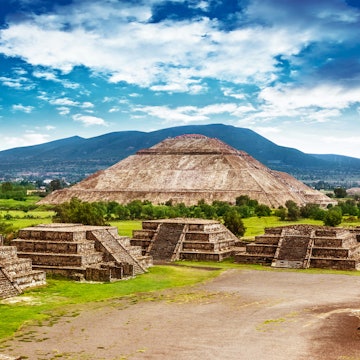
Sep 15, 20203 min read
Mexico's tourist attractions are starting to welcome visitors back under new rules
Feb 7, 2020 • 4 min read

Río Bec is one of the most remote sites of ancient Mayan architecture that you can visit, but the adventure of getting there is part of what makes it worth it © Ray Bartlett / Lonely Planet
The Río Bec ruin is buried deep in the Reserva de la Biósfera de Calakmul, a vast jungle on the border of the states of Campeche and Quintana Roo. Its remote, challenging to get to and totally worth the effort. Here are our tips and tricks on how to explore this lesser-visited and amazing example of Mayan architecture.
Not to downplay the value of a visit to Chichén Itzá, as it is a well-preserved ruin that has many unique features and a wealth of historical info that’s known. But let’s be honest: it loses something valuable when to get there you have to wait in line for a half an hour in a herd of people, when every picture you take has to be timed just right to avoid photobombs of other tourists, and when bus tour after bus tour fills the site to capacity. Río Bec, on the other hand, will be yours to explore. If even one other couple is there it’ll be the equivalent of a crowd.

Unlike its nearby ruin neighbor, Calakmul, Río Bec isn’t a place you can drive a regular car to, nor can you even go by yourself unless you want to get lost in a maze of never-ending logging roads that crisscross the jungle. You’ll need to arrange for a guide beforehand, and most likely, take an ATV. A 4x4 vehicle can make it in the driest of the dry season; otherwise, prepare to get stuck in thick, cement-like mud until an ATV comes by. The only ruin more remote lies across the border, in Guatemala: El Mirador. Ka'an Expeditions can set up excursions to the site.
Getting to Río Bec, with all the bumps and stops and pitfalls, is half of the fun. It’s so rare that one gets to truly embark on a route with any real wildness or risk, and as the jungle closes around you, as the sounds of civilization are replaced by that of parrots calling in the trees, of monkeys shaking the branches, and of insects the size of saucers, it feels like a truly wild, dangerous, yet mystical land filled with promise and possibility and discoveries of all sorts at every turn.

Once you’ve arrived, which can take anywhere from an hour and a half to three hours, plan on visiting both Group A and Group B. The A Group is a fascinating structure with steps, chambers, even a cool (or creepy) staircase leading down inside, all you need is an Indiana Jones hat, a bullwhip and a bag of sand to feel like you're the star of Raiders of the Lost Ark. Note that while you can clamber around (carefully) on the outside of the ruin, if you slip, trip, or break something, you’ll have a long and bumpy ride to the nearest hospital. Stairs are cordoned off for safety.
The B Group, the only other excavated section that tourists commonly visit, is impressive: two similar structures on either side bear a striking similarity with the monuments in Tikal. Here though, they are unique, with false temples at the top, and intricate sets of false, near-vertical stairs leading up to them. Above the false door is a monster or deity, and several other distinguishing marks make it clear that this is true Río Bec style.
In fact, this is the structure for which the style was named. Only here at this structure can you see all five elements combined. A false temple, false stairs, checkerboard pattern, roofcombs, and fake columns supporting the base. Fascinating how much of this style is false – as if these architects were trying to mimic another style without actually doing the hard work.

There are other things to see, and several that you won’t. Jaguars, cougars and several species of smaller cats are hidden here, tucked into the jungle, visible for a flash or a glimpse if visible at all. Our guide picked out a track, large as a saucer and freshly imprinted into the mud, that was either a jaguar or cougar. We saw numerous bird and insect species. And a spider monkey or two, who gawked at the earth-bound intruders before scampering off in the canopy.
This ruin is as remote as it gets, yet for anyone willing to spend a day in the jungle, it’s surprisingly accessible. If time permits, a few other ruins lie on the trek out: Ramonal, known for its “Chevy-symbol”-like markings; Kajtún, a large city with numerous stellae (obelisks inscribed with Maya glyphs); Okolhuitz, with an impressive roofcomb and towering human figure overlooking the jungle canopy.
Get more travel inspiration, tips and exclusive offers sent straight to your inbox with our weekly newsletter.